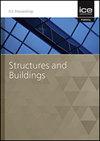新型椰子树茎型头剪连接件的三维有限元分析
IF 1.4
4区 工程技术
Q3 CONSTRUCTION & BUILDING TECHNOLOGY
Proceedings of the Institution of Civil Engineers-Structures and Buildings
Pub Date : 2023-03-16
DOI:10.1680/jstbu.21.00169
引用次数: 1
摘要
头螺柱是组合结构中的剪切连接件,用于钢梁和混凝土板的相邻面。在本研究中,在不改变整体材料体积的情况下,将传统的头螺柱形状重组为类似椰子树茎的形状,旨在提高复合连接的抗剪强度。本文提出了用于复合材料结构的六种新型剪切连接器,即椰子棕榈茎皇家型头螺柱剪切连接器(CPSR螺柱)。采用Abaqus/Explicit对推出试样进行建模。所提出的有限元模型得到了验证,实验结果已在文献中发表。六种不同形式的CPSR螺柱包裹在三种等级的混凝土(C40、C50和C60)中,研究了抗剪强度、刚度和荷载滑移性能。将创新型CPSR铆钉与均匀截面头钉的分析结果进行了比较,结果表明,在C40、C50和C60级混凝土中嵌入时,CPSR钉的抗剪连接极限强度分别提高了35-41%、37-44%和41-52%。因此,在不改变螺柱材料整体体积的情况下,最终在提高了头螺柱剪切连接抗剪强度能力的情况下实现经济的体现。本文章由计算机程序翻译,如有差异,请以英文原文为准。
3D finite element analysis of innovative coconut palm stem shaped headed shear connectors
Headed studs are the shear connectors in composite structures used at the adjoining face of a steel beam and concrete slab. In this research, the conventional shape of a headed stud is restructured to resemble a coconut palm stem shape without change in overall material volume, aiming to improve the shear strength of the composite connection. Six innovative shear connectors named coconut palm stem royal-shaped headed stud shear connectors (CPSR studs) are proposed here for composite structures. The Abaqus/Explicit has been employed to model a push-out specimen. A proposed FE model was successfully validated with the experimental result published in the literature. The six different forms of CPSR studs encased in three grades of concrete (C40, C50, and C60) have been studied for shear strength, stiffness, and load-slip performance. Comparison of findings of the analysis of innovative CPSR studs have been made with uniformed cross-sectional headed studs, and results show the 35-41%, 37-44%, and 41-52% improvement in the ultimate strength of the shear connection when embedded in C40, C50, and C60 grade concrete, respectively. So, ultimately achieving economic reflection with improved shear strength capacity of headed stud shear connection without change in the overall volume of stud material.
求助全文
通过发布文献求助,成功后即可免费获取论文全文。
去求助
来源期刊
CiteScore
3.40
自引率
6.20%
发文量
61
审稿时长
12 months
期刊介绍:
Structures and Buildings publishes peer-reviewed papers on the design and construction of civil engineering structures and the applied research associated with such activities. Topics include the design, strength, durability and behaviour of structural components and systems.
Topics covered: energy conservation, people movement within and around buildings, strength and durability of steel and concrete structural components, and the behaviour of building and bridge components and systems

 求助内容:
求助内容: 应助结果提醒方式:
应助结果提醒方式:


